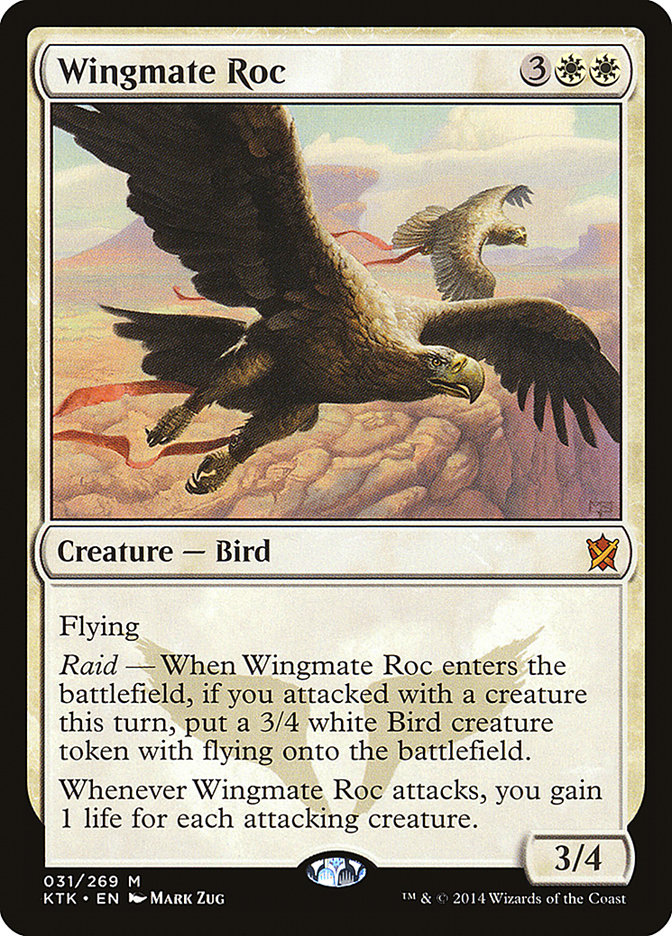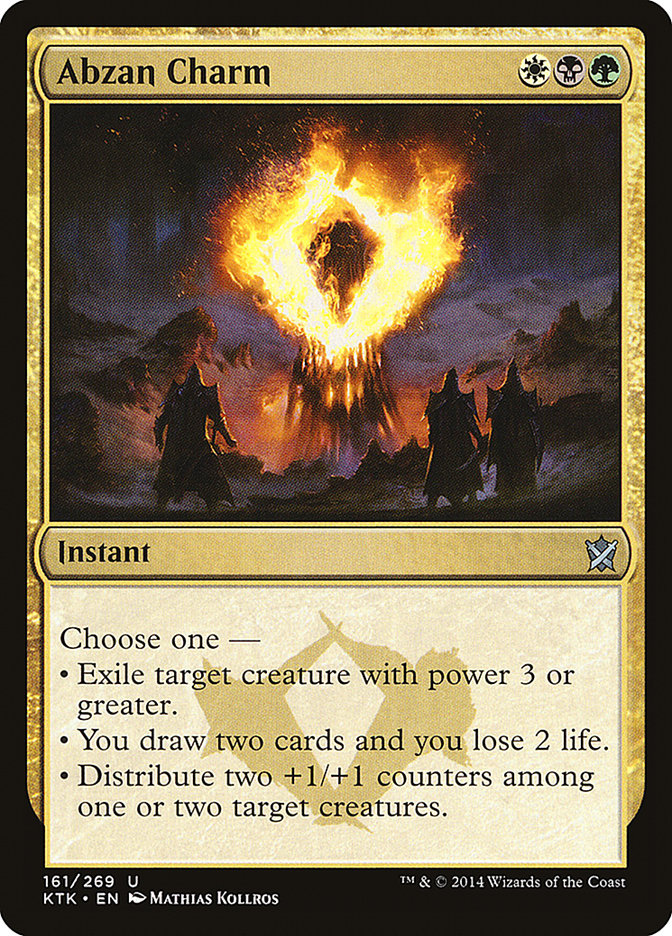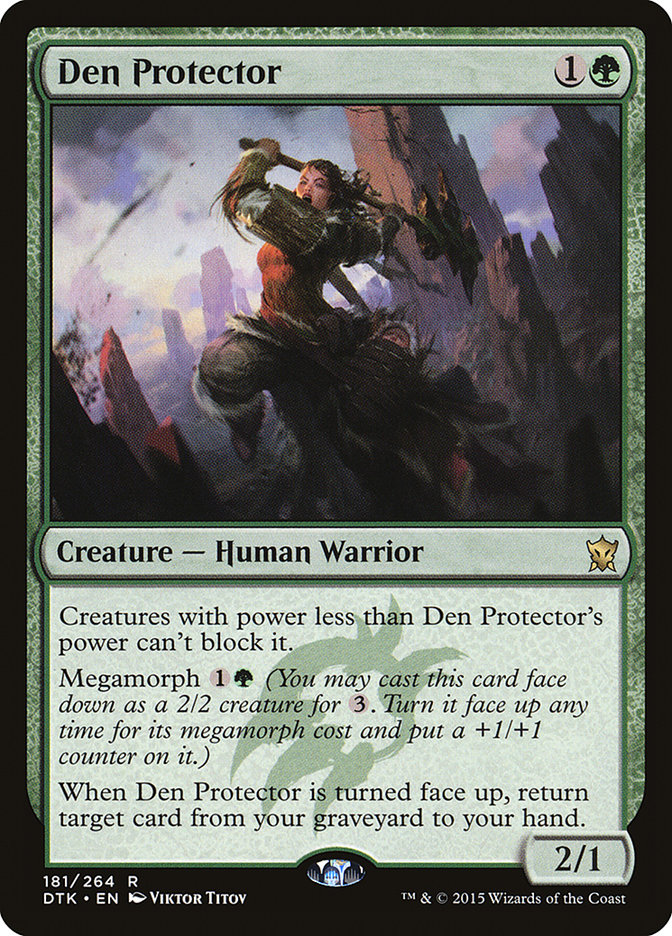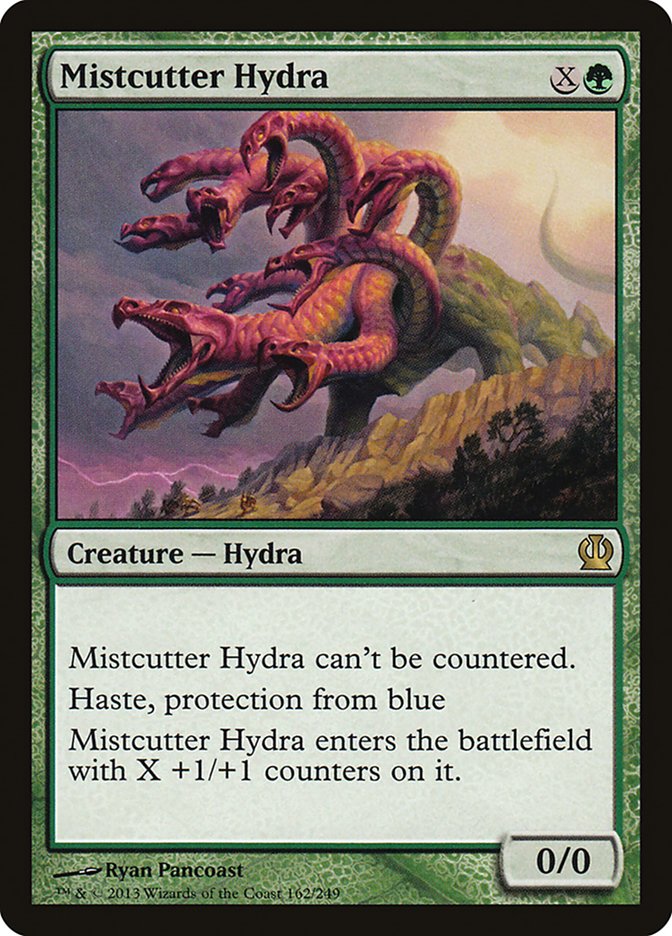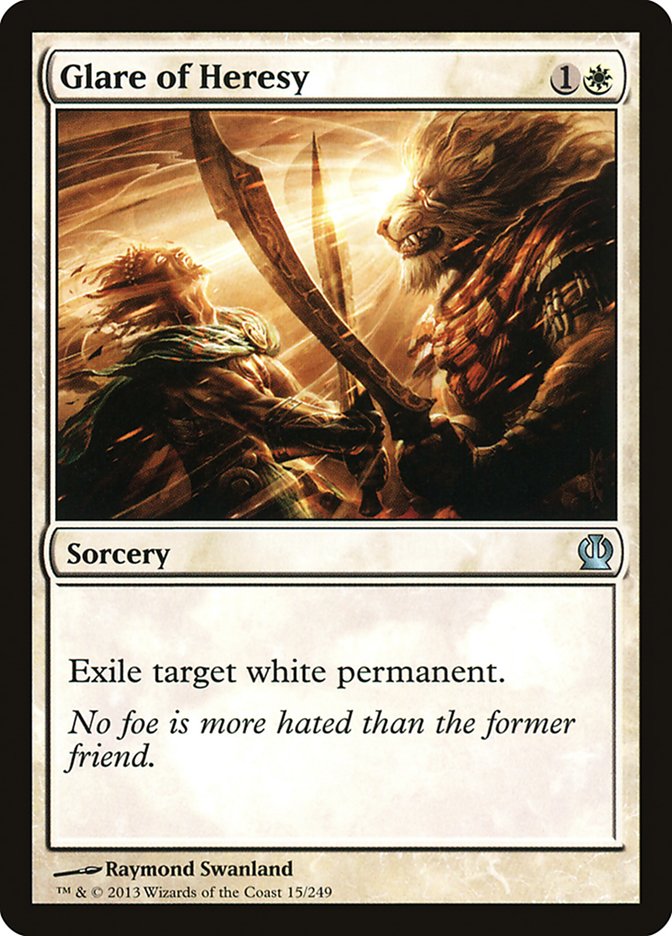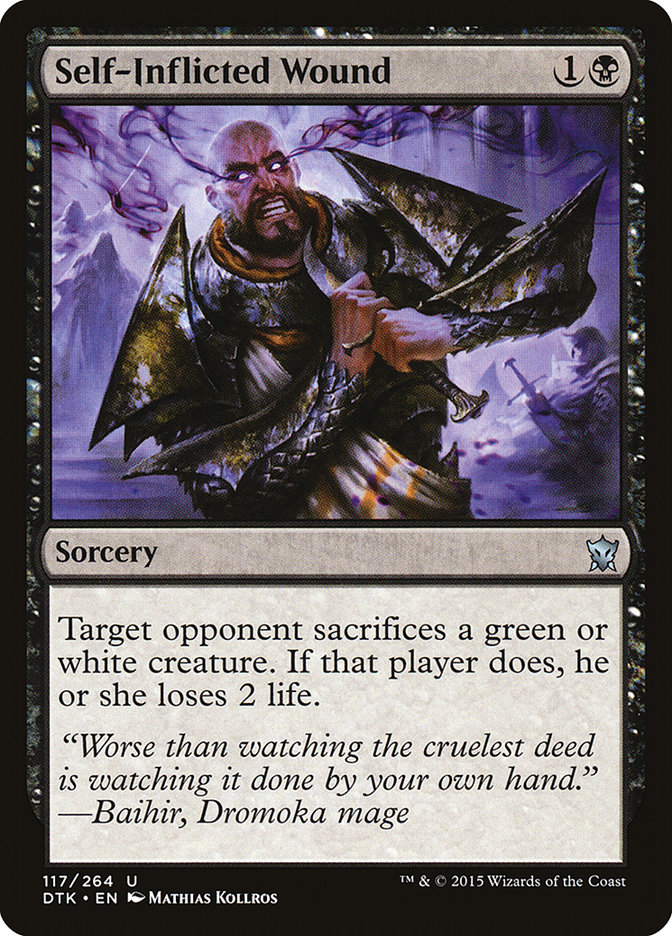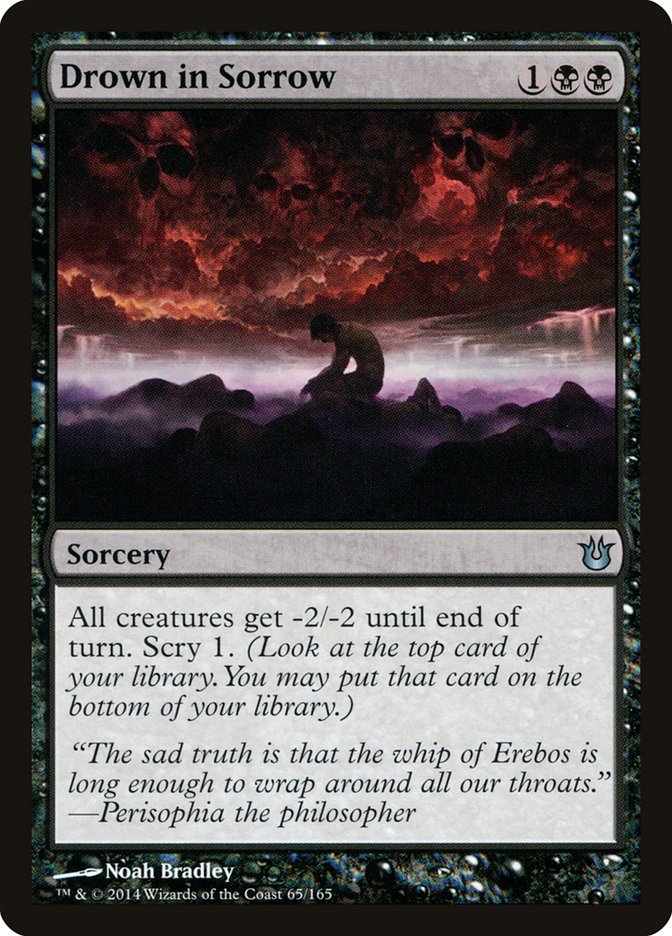You can only lose to a deck so many times before you wonder why you aren’t playing it yourself.
I left rainy Renton to head down to Virginia Beach for Todd Anderson’s surprise birthday. My computer came with me, but I only had a passing interest in
playing in the MOCS. It was Standard, which is what I was the most familiar with, but the Saturdays I wake up early to play a big tournament on Magic
Online generally end with me dropping at 0-1 and going back to bed.
This time, I won the whole thing.
At first, me playing the MOCS was this thing that was happening in the background, which was distracting from the fun of the weekend. I mentioned several
times that if I lost a match early on, I would drop, but that didn’t happen until I was 7-0 and a soft lock for Top 8.
By the time I was in Top 8, people around the house had gotten invested.
Intense MOCS finals! @fffreakmtg @G3RRYT @strong_sad pic.twitter.com/YbEEHm1Coz
— Tom Ross (@Boss_MTG) May 10, 2015
After my opponent conceded Game 3 of the finals, I did a lap around the house high-fiving people. I won an invite to Pro Tour Origins, an invite to the
Magic Online Championships next year, several thousand dollars, and a pile of MTGO riches.
This is what I played:
Creatures (20)
- 4 Fleecemane Lion
- 4 Anafenza, the Foremost
- 2 Wingmate Roc
- 4 Rakshasa Deathdealer
- 4 Siege Rhino
- 2 Warden of the First Tree
Planeswalkers (1)
Lands (22)
Spells (17)

The day before, Brad and Todd each asked me what I was playing in the MOCS. Both times, I replied with, “A bad deck, don’t worry about it.”
I wasn’t in the mood to discuss things and didn’t even do as much research as I would have normally done. Was my manabase correct? Almost certainly not. I
probably could have cross-referenced with a bunch of other Abzan Aggro manabases to see if we had the same number of each sources and the same number of
enters-the-battlefield-tapped lands, but I didn’t bother.
Were my sideboard plans fluid? I didn’t try mapping them, so I didn’t exactly have any.
I hadn’t even played a game with the archetype before the tournament.
Don’t try this at home, kids.
In reality, it’s a testament to absorbing as much information as possible, being practiced playing against the other decks in the format, and being able to
play different strategies to understand what you need to be doing. My decklist might not be great, and I might have made some smaller errors, but I don’t
think I made many tactical errors.
So why did I end up playing Abzan Aggro?
Well, the secret to doing well in Standard lies in knowing when to listen to Brad Nelson and when to ignore everything he says. After Grand Prix Toronto,
he said that his (BBD’s) Abzan Aggro deck was bad, but he finished in the Top 4. He didn’t like the deck and said his sideboard was garbage. For the most
part, I disagreed.
Each week, Brad is looking for the deck that is perfectly positioned. Meanwhile, I’m mostly fine with just having a deck that is good enough. For last
weekend, and probably forever, Abzan Aggro qualifies as good enough. You have a bunch of powerful, resilient creatures that must be dealt with, some of the
best removal, disruption, and split cards in the format. Your mana is taxing, but you should want to play 26 lands because there is no shortage of things
to use your mana on.
Just look at the deck — It’s basically all gold cards! Those are, on average, more powerful than what your opponent is doing at each spot on the curve.
You might lose to a lategame Elspeth, Sun’s Champion, but so do most of the green decks in the format.
There might be some people out there that truly want to beat Abzan Aggro, and you might lose to them. By definition, that means that Abzan Aggro is not the
best choice for this specific week. However, you might beat those people anyway, thanks to your cards being so powerful and proactive.
This deck is quite good, but it’s not good enough that it’s your only option. It’s very beatable, but it’s rock solid and doesn’t have too many truly
terrible matchups.
The “Tournament Report”
To the best of my recollection, this is how the tournament went:
Round 1: Esper Dragons, 2-1
Round 2: Atarka Red, 2-1
Round 3: Bant Heroic, 2-0
Round 4: Atarka Red, 2-0
Round 5: Esper Dragons, 2-0
Round 6: Abzan Control, 2-1
Round 7: G/W Aggro, 2-1
Round 8: Abzan Control, 1-2
Round 9: Jeskai Aggro, 1-2
Top 8: G/W Aggro, 2-1
Top 4: Abzan Control, 2-0
Finals: Jeskai Aggro, 2-1
Most of my matches were close, but a lot of them were pretty huge blowouts in my favor. That’s the strength of playing a deck like this. I used to
gravitate towards decks that allowed me to play Magic for longer, but that basically meant I was handicapping myself because I wasn’t getting any “free”
wins. It might be less satisfying, and it might mean you don’t get to play close, interactive, fun games of Magic as often as you’d like, but at the end of
the day, playing something that is good at winning is all that matters.
26 Land
The most frequent question I’ve gotten about my list has been, “Why do you have so many land?” The answer is that, despite being an aggressive deck, this
deck wants a lot of mana. There are a few reasons.
1) Your cards have a lot of colored mana symbols in them. In order for your deck to function, you’ll want a certain amount of lands that produce each
color, and a comfortable amount might not be achievable with only 25 land.
Say you play 25 land but want 18 lands that produce black, you can’t really get that without playing 26 land. Every land makes black mana except for
Windswept Heath and the lands it fetches, and you don’t really want to cut any of those, which would leave you with only 17 lands that can produce black.
Ultimately, the amount of colored sources you decide you “need” for each color is rather arbitrary, but I tend to set a high bar for myself. I want my deck
to function because if I’m able to do what my deck does, I feel like I’m a favorite. If you never get off the ground, it’s very difficult to win. Coming
back from behind doesn’t happen often in this Standard format, so I don’t want to start on the back foot.
2) If you find that you have too many lands that enter the battlefield tapped, but you need those dual lands to meet your color requirements (and you don’t
want to swap a Temple of Malady for a Llanowar Wastes because you don’t want another painland), adding a land will give you more options for how to
sequence your lands.
For example, a hand with Sandsteppe Citadel, Temple of Malady, and Plains will give you difficult choices, depending on what your hand is. When you add an
additional land to your deck, sometimes that hand will include an additional land, like a Mana Confluence, and then you’ll have a lot more freedom to
decide which turn you want to deploy certain lands. That should go a long way to ensuring you’re able to curve out comfortably rather than having a draw
with too many lands that enter the battlefield tapped or too many painlands that will end up costing you games.
3) If playing 26 land is preferred for sequencing and manafixing, the issue of flooding then arises. However, this is probably the best deck in the format
for finding ways to use its excess mana. Fleecemane Lion, Rakshasa Deathdealer, and Warden of the First Tree are phenomenal mana sinks, so you rarely end
up feeling flooded. Instead, you get to feel like you’re getting the maximum potential out of each of your cards.
As I mentioned in the first bullet point, I am far more concerned with being able to cast my spells on time than trying to have more gas in the midgame.
After all, if you never get off the ground, you probably won’t make it into the midgame. Even if you do, you’ll probably be behind and won’t last long.
Additionally, this deck doesn’t even like being in the lategame because most decks have things like Elspeth, Sun’s Champion that can overpower it. There
are some decks where a lategame Rakshasa Deathdealer functions like The Abyss and eventually kills them, but most of the bad matchups have cards that go
over the top of you.
There is a certain risk/reward decision that goes into building any manabase. In this case, the risk of being manascrewed far outweighs the reward of
drawing slightly better in the midgame. You mulligan less with more lands, have a higher chance of curving out appropriately, and rarely feel flooded. For
me, 26 land is a no-brainer.
Some Situations
This deck can be difficult to play. Sometimes you curve out and their cards don’t line up well against yours, but other times your sequencing can be the
difference between winning and losing. As is the case with most decks, Abzan Aggro is relatively easy to play on auto-pilot, but difficult to play to
perfection.
I ran into a couple situations during the MOCS that I thought were interesting enough to discuss.
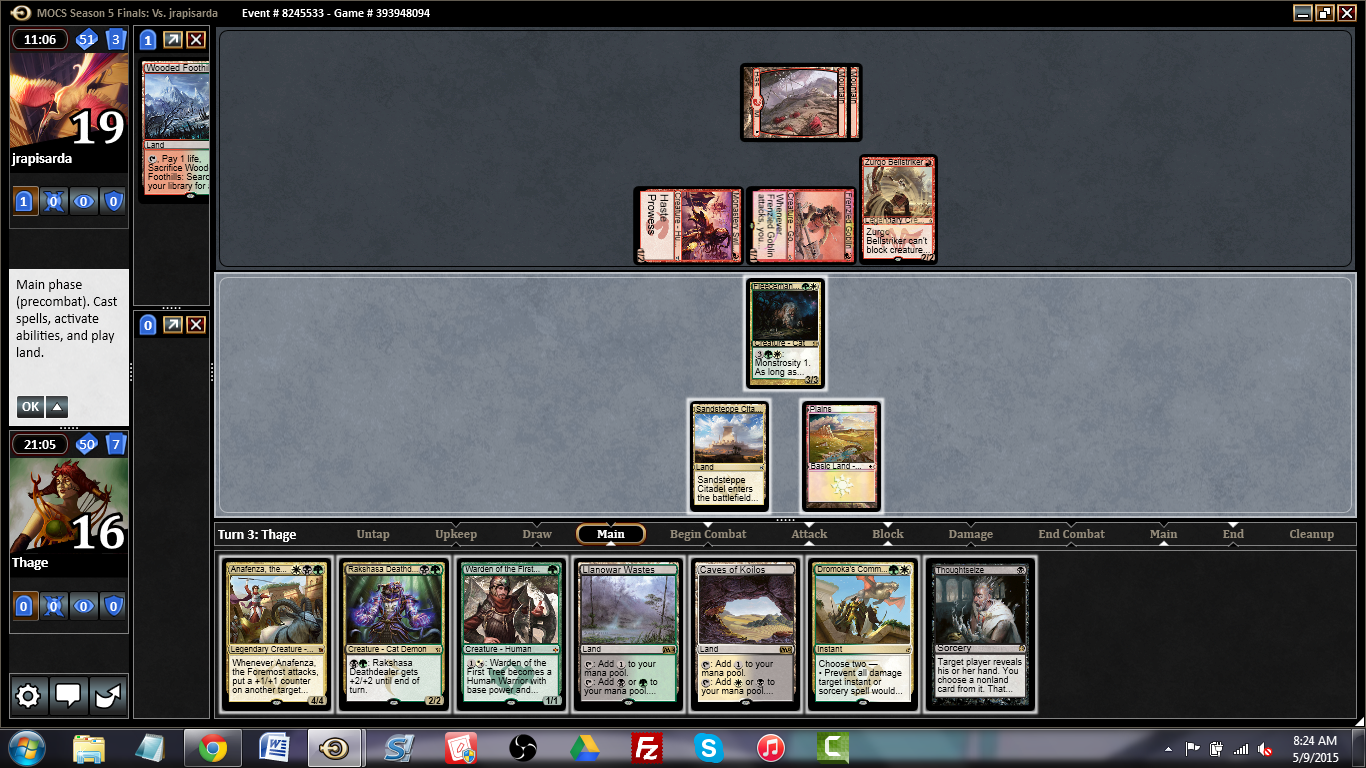
My opponent was on the play but missed a land drop. I was able to untap with Fleecemane Lion, so it’s unlikely my opponent had a Lightning Strike. Stoke
the Flames is a possibility, but they likely would have used that as well in order to not get destroyed by a Dromoka’s Command later on.
I had plenty of options, including using Thoughtseize and Dromoka’s Command, playing two creatures, playing Thoughtseize plus a creature, or just jamming
Anafenza, the Foremost.
In the end, I decided to play Anafenza, the Foremost. I was fairly certain my opponent didn’t have either of the big burn spells in their hand, which meant
that their Frenzied Goblin wasn’t going to force through a great attack. Goblin Heelcutter wasn’t enough to lead to a great attack either. I felt
relatively confident that Anafenza, the Foremost would mostly stabilize me on that board.
On the following turn, I’d have a plethora of options, each of which was good, and I’d be able to turn the corner quickly by going on the offensive.
Against aggressive red decks, you should be looking to close the door as soon as possible so that they don’t have the time to draw into enough burn to
finish you off.
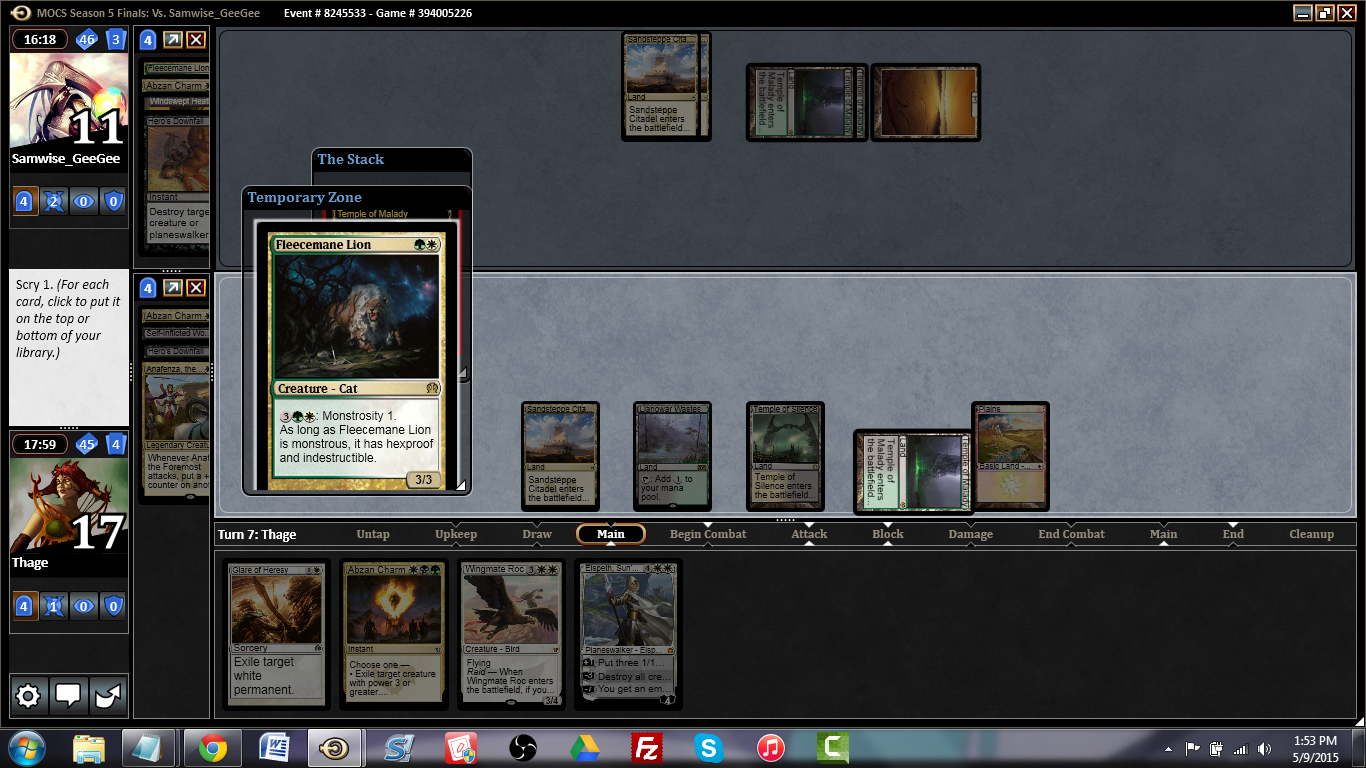
This one was a little more interesting. I was playing against Abzan Control and was pretty well set up to win. Normally I would be perfectly happy firing
off my Abzan Charm in my main phase to draw some cards, but I didn’t know if my opponent’s hand was stacked with Siege Rhinos, in which case I might want
to use the Abzan Charm to kill one. I had a Glare of Heresy, but I wanted to save that for a potential Elspeth, Sun’s Champion if possible, as that is the
best card against me.
I scryed into a Fleecemane Lion and had to choose between keeping a perfectly reasonable spell or shipping it. I can make arguments for both sides.
On one hand, Fleecemane Lion is quite good against Abzan Control, but everything is contextual. If my opponent has a parade of Siege Rhinos or even an
Elspeth, Sun’s Champion, Fleecemane Lion doesn’t help too much. On the other hand, I have removal for those things and a Wingmate Roc that I’d like to
raid, so having the attacker is nice.
However, I’m kind of light on mana with some expensive cards, so I probably won’t have the time to use monstrosity anytime soon. Hitting that sixth land
for my own Elspeth, Sun’s Champion would be nice as well. Even if it died to a Hero’s Downfall, I’d be able to raid the Wingmate Roc thanks to the tokens
left behind.
Overall, I think it’s close, but I think it’s more likely that the Fleecemane Lion would be brickwalled by my opponent’s better cards, so I chose to put it
on the bottom. I’m still not sure what’s correct.
The Maindeck
The only time I fully leveled Warden of the First Tree, I lost that game. That is somewhat indicative of how the games play out, but the threat was real,
and it often meant they had to kill it instead of one of your other threats.
It’s cheap to play, which is very important. You can use it, Thoughtseize, or Temples to fill your curve, which is excellent to have when you’re looking to
curve out every game.
This is, in my opinion, one of the best reasons to be playing Abzan Aggro. With the green midrange mirrors being fought on the ground, taking to the skies
is the next step. Having a built-in resiliency to removal is just icing on the cake.
From BBD’s/Brad’s Grand Prix Toronto decklist, I added a third to the 75, but I’m definitely looking to slot in the fourth somewhere.
If Wingmate Roc wasn’t the best reason to play Abzan Aggro, this would be the best reason. Sure, you can play Abzan Charm in any ole Abzan deck, but this
deck makes the best use out of it by far. The +1/+1 counters mode is incredibly relevant, exiling creatures is a unique, powerful effect in a format full
of Deathmist Raptors, and the Sign in Blood mode is potent in grindy matchups.
There are some places you want to sideboard it out, but there is no reason not to play four maindeck.
The Sideboard
The night before the tournament, I went through my collection and added all the cards I wanted to the sideboard, which amounted to over twenty cards. I
slowly trimmed some cards while trying to keep an eye on how many I wanted to sideboard in against the popular decks, but there wasn’t an exact science to
it. I stopped when I got to fifteen and that’s what I registered.
Den Protector was the focal point of BBD’s sideboard, but I wasn’t going to drink the kool-aid. You can’t play the same grindy, attrition-based game that
the control decks play when they are drawing Elspeth, Sun’s Champion or Ugin, the Spirit Dragon, and you’re drawing more dopey creatures. If I had access
to Disdainful Stroke, it would be a reasonable sideboard plan, but I was looking to end the game, not make it last longer.
Here’s where I would love to say that Mistcutter Hydra over-performed and it was a genius addition and it was the only reason I won the tournament.
Unfortunately, that would be a lie. I brought it in twice, never drew it, and won those matchups anyway. I like it in theory, but perhaps it’s not
necessary.
I might sound like a broken record at this point, but Elspeth, Sun’s Champion is an issue. Patrick Chapin’s article isn’t going to make that any better for us.
Beating a resolved Elspeth, Sun’s Champion is doable if you are able to kill it immediately, so I can’t see cutting Glare of Heresy.
While I would love to load up on Self-Inflicted Wound in various matchups, the space does not exist in the sideboard. We already have Glare of Heresy,
which accomplishes a similar goal in the mirror match, plus Self-Inflicted Wound will eventually get trumped by Wingmate Roc or Elspeth, Sun’s Champion.
There is enough removal to almost guarantee you’ll end up in the midgame, at which point you need haymakers to close the door, not just a removal spell.
Playing some copies is fine, but loading up on them doesn’t actually help.
I respect red decks more than most, and I have not been impressed by Drown in Sorrow against Martin Dang’s Atarka Red deck. Dash and various token makers
make Drown in Sorrow look foolish at times, so that wasn’t a card I wanted to load up on.
Granted, this deck is a better spot for Drown in Sorrow than Esper Dragons, since often times you just want to destroy their first wave and go on the
offensive. Esper Dragons is forced into playing a longer game, so Atarka Red is able to slowroll its threats more easily. If they try doing that against
Abzan Aggro, they’ll probably just get run over.
Still, Drown in Sorrow is not something I wanted to draw multiple copies of, nor is it something I felt like I needed, so I only played two.
Going Forward
Abzan Aggro is a great deck, but it’s not without its issues. Regardless, I’ll probably be playing it for the near future, at least until there are enough
decks in the metagame that I’m legitimately scared of. As of now, that isn’t the case, so my choice is easy.


